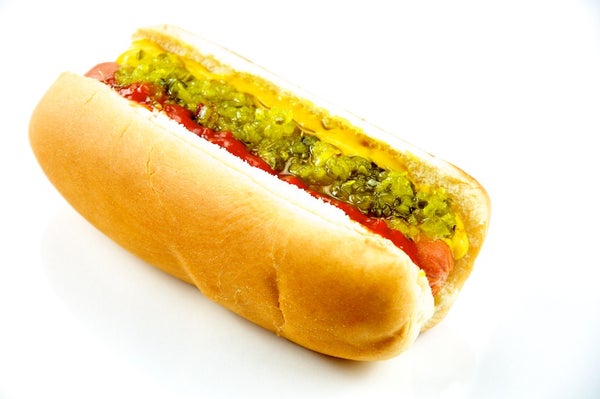This article was published in Scientific American’s former blog network and reflects the views of the author, not necessarily those of Scientific American
This Fourth of July holiday, collectively Americans will eat some 150 million hot dogs, according to industry analysts. Lined up, that substantial serving of frankfurters would stretch from sea to shining sea—several times.
As of last year, franks made by industry stalwart Oscar Mayer (from Kraft) got knocked out of first place for most-consumed dogs by Sara Lee's Ball Park brand, according to Adweek (excluding sales data from Walmart).
So just what's in these wieners? Here's a quick look at the ingredient list:
On supporting science journalism
If you're enjoying this article, consider supporting our award-winning journalism by subscribing. By purchasing a subscription you are helping to ensure the future of impactful stories about the discoveries and ideas shaping our world today.
Mechanically separated turkey: As the U.S. Department of Agriculture (USDA) describes it, this "paste-like and batter-like poultry product [is] produced by forcing bones, with attached edible tissue, through a sive or similar device under high pressure." Unlike mechanically separated beef or pork, it can be present in hot dogs in "any amount."
Pork: Per 1994 USDA rules, any "meat" can be taken off the bone by "advanced meat recovery (AMM) machinery" that separates the edibles from the inedibles without smashing the bone.
Water: Hot dogs must be less than 10 percent water, according to the USDA.
Corn syrup: This common food ingredient—which is made differently from high-fructose corn syrup and has not been linked to the same health concerns—is often used to add texture and sweetness.
Beef: After the outbreak of mad cow disease, the USDA stopped allowing any mechanically separated beef in food.
Salt: A necessary mineral; each of these hot dogs contain about 20 percent (480 milligrams) of the recommended daily allotment.
Potassium lactate: Made from neutralized lactic acid, it's a common meat preservative because of its properties as an antimicrobial, capable of killing off harmful bacteria.
Sodium phosphates: Any of three sodium salt of phosphoric acids that can be used as a food preservative or to add texture.
Flavorings: Under current U.S. Food and Drug Administration guidelines, most combinations of flavoring agents are okay to just be listed as "flavor" rather spelled out individually.
Beef stock: Meat stocks are usually made by boiling water with pieces of muscle, bones, joints, connective tissue and other parts of the carcass.
Sodium diacetate: A combination of sodium acetate and acetic acid, it helps to fight fungus and bacterial growth and is often used as an artificial flavor for salt and vinegar chips—and in the sodium acetate form, it's found in instant hand warmers.
Sodium erythorbate: A sodium salt of erythorbic acid, it has replaced the use of sulfites in many foods and serves as a preservative and to help keep meat-based products pink. Some people report side effects, including dizziness, gastrointestinal issues, headaches and, if consumed in large quantities, kidney stones.
Maltodextrin: A compound made from cooked starch (often corn in the U.S. and wheat in Europe) that is used as a filler or thickening agent in processed foods. Brewers also often use it in beer.
Sodium nitrate: This common preservative helps meats retain their color and also keep foodborne illnesses, such as botulism, to a minimum. Animal studies have linked sodium nitrates to an increased risk of cancer. It's also frequently found in fertilizers and, yes, fireworks.
Extractives of paprika: An oil-based extract from the paprika plant, it can give processed food color and increase shelf life.
Served bunless on its own, one of these doggies will cost you about 180 calories and include about a quarter of your suggested daily amount of fat (15 grams of total fat, five grams of which are saturated).
Oscar Mayer Classic Wieners have a similar ingredient list: Mechanically separated turkey, mechanically separated chicken, pork, water, salt, ground mustard seed, sodium lactate, corn syrup, dextrose, sodium phosphates, sodium diacetate, sodium acorbate, sodium nitrate, and flavor.
With a fast-growing concern among consumers about processed food ingredients, hot dog-makers are introducing alternative products (while keeping the heavy hitters on the market). Last year, Kraft launched a campaign promoting its Oscar Mayer Selects line of hot dogs, which are made sans artificial preservatives. According to Advertising Age, Sara Lee fired back by promoting its Ball Park Deli Style Beef Franks that have no by-products or artificial flavors.
And the hot dog battle doesn't show signs of slowing. The two top companies now offer at least 34 hot dog varieties between them, ranging from Ball Park's Cheese Franks to Oscar Mayer's XXL Premium Beef Franks. And in the fight for a slice of the processed meat pie, a lot of dough is at stake. According to the National Hot Dog and Sausage Council industry group, U.S. supermarkets alone sold more than $1.6 billion worth of hot dogs last year. That's a lot of beef—and pork, and turkey, and chicken.
